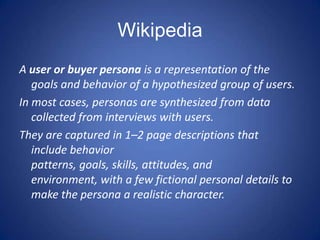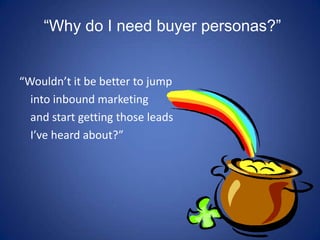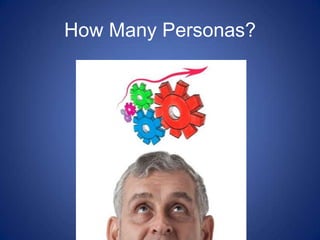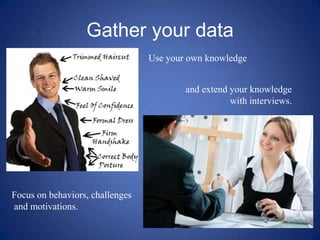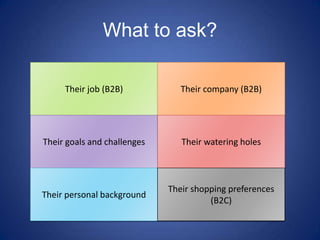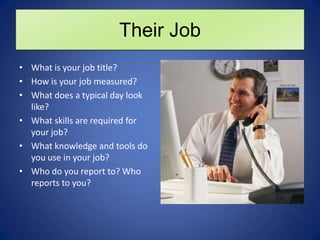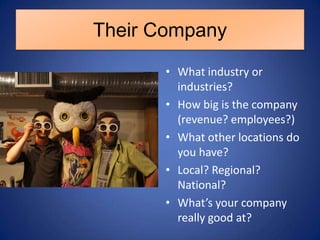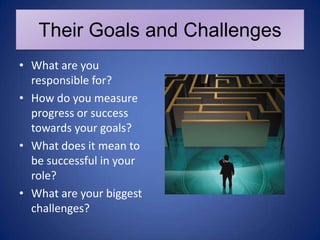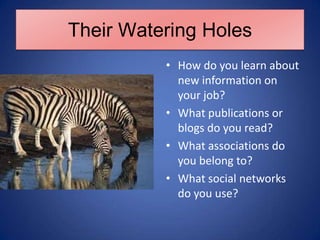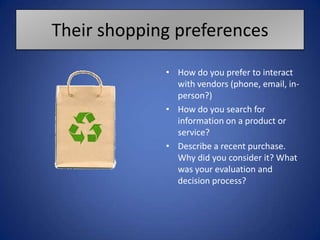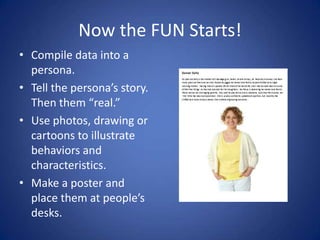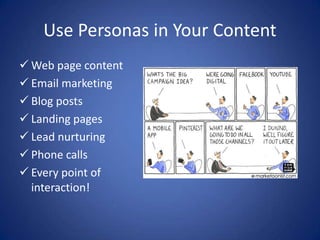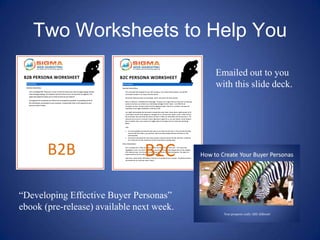How to Create your Buyer Personas
- 1. How to Create Your Buyer Personas Your prospects really ARE different!
- 2. How to Create Your Buyer Personas Larry Levenson Chief Inbound Officer Sigma Web Marketing larry@sigmawebmarketing.com 480.359.5501 HubSpot Partner Agency
- 3. Archetype • Archetype; not a person, not a customer profile! • Describes goals and observed behavior patterns • Applies to potential customers, customers, and referral partners • A fictional character that represents your ideal prospect.
- 4. Wikipedia A user or buyer persona is a representation of the goals and behavior of a hypothesized group of users. In most cases, personas are synthesized from data collected from interviews with users. They are captured in 1–2 page descriptions that include behavior patterns, goals, skills, attitudes, and environment, with a few fictional personal details to make the persona a realistic character.
- 5. “Why do I need buyer personas?” “Wouldn’t it be better to jump into inbound marketing and start getting those leads I’ve heard about?”
- 7. Gather your data Use your own knowledge and extend your knowledge with interviews. Focus on behaviors, challenges and motivations.
- 8. What to ask? Their job (B2B) Their company (B2B) Their goals and challenges Their watering holes Their shopping preferences Their personal background (B2C)
- 9. Their Job • What is your job title? • How is your job measured? • What does a typical day look like? • What skills are required for your job? • What knowledge and tools do you use in your job? • Who do you report to? Who reports to you?
- 10. Their Company • What industry or industries? • How big is the company (revenue? employees?) • What other locations do you have? • Local? Regional? National? • What’s your company really good at?
- 11. Their Goals and Challenges • What are you responsible for? • How do you measure progress or success towards your goals? • What does it mean to be successful in your role? • What are your biggest challenges?
- 12. Their Watering Holes • How do you learn about new information on your job? • What publications or blogs do you read? • What associations do you belong to? • What social networks do you use?
- 13. Their personal background • Describe your personal demographics. • Describe your educational background. • Describe your career path. How did you end up here?
- 14. Their shopping preferences • How do you prefer to interact with vendors (phone, email, in- person?) • How do you search for information on a product or service? • Describe a recent purchase. Why did you consider it? What was your evaluation and decision process?
- 15. Now the FUN Starts! • Compile data into a persona. • Tell the persona’s story. Then them “real.” • Use photos, drawing or cartoons to illustrate behaviors and characteristics. • Make a poster and place them at people’s desks.
- 16. Remember. . . They are archetypes, not real people!
- 17. Use Personas in Your Content Web page content Email marketing Blog posts Landing pages Lead nurturing Phone calls Every point of interaction!
- 18. Two Worksheets to Help You Emailed out to you with this slide deck. B2B B2C “Developing Effective Buyer Personas” ebook (pre-release) available next week.
Editor's Notes
- A buyer persona is an archetype. It’s a fictional character that represents your ideal prospect. It is not a customer profile, although it usually contains dome demographic information. It is an in-depth, composite of characteristics, behaviors and motivations of your ideal customer. When complete, it will help you understand the motivating beliefs, fears and secret desires that influence your customer’s buying decisions.
- Developing a buyer persona requires thought, consideration and time – it is not a slap-dash exercise. It is also not something you can do in a vacuum. You cannot create personas out of thin air, even if your think you know what your ideal customer is like.Why do you need personas? The better question is “How successful you can be with a seat-of-the-pants approach?” The best marketers focus their message on the prospect, not on their own product or service. If you don’t know who your target is, and what their problems, frustrations and needs are, how can you expect to even attract them with what you offer, much less make a sale? Developing buyer is an integral part of successful inbound marketing. Using personas helps you get the right type of traffic, leads and customers, informs the kind of content you want to create and focuses your message on the prospect. Theexercise of creating your buyer personas can lead to a dramatic transformation in your whole business.
- Most businessesdon’t have more than 3 to 5 personas because, remember, they are archetypes, not customer profiles. Your personas will not necessarily be aligned with your market segments. Differences in industry, job title, and company size & revenue (for B2B companies) or age, gender and family status (for B2C companies) don’t equate to different personas. Differences in HOW they buy – what tools they use to research, what criteria they use for evaluating, what challenges and objections they have – reveal more about them than any demographics ever can.
- CONDUCT INTERVIEWS of some of your best customers, recent prospects who didn’t buy, and those who aren’t your customers yet but you’d like them to be. It is relatively easy to define demographics, but your competitors also have that information. Get the information that gives you true insight into your customer. Ask those you interview questions that get to the heart of their buying behavior. Have a few questions as a starting point, but let their answers direct the conversation.
- Use the worksheet to help you formulate a few questions you’ll begin with in your interviews. These may not be the only questions you’ll address, since the conversation may take you in different directions, but they are a good place to start. You’ll do better with an unscripted conversation than a strict set of questions. Let the interviewees tell you what they want to communicate. That will tell you immensely more about them than if you ask questions they aren’t interested in answering. You’ll get more complete answers, and answers from the heart rather than just what they think you want to hear. Remember to focus on motivating factors rather than demographic information. A lot of demographics are available on the ’net; your sales team may have a lot of that information already; or if it’s not available otherwise, you could email a short questionnaire before your interview.
- Use the worksheet to help you formulate a few questions you’ll begin with in your interviews. These may not be the only questions you’ll address, since the conversation may take you in different directions, but they are a good place to start. Remember to focus on motivating factors rather than demographic information. Let the interviewees tell you what they want to communicate. That will tell you immensely more about them than if you ask questions they aren’t interested in answering. Understanding your ideal customers’ motivations will guide your content creation and separate you from your competitors.




